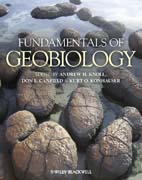
For more than fifty years, small numbers of scientists have been concerned with the interrelationships of Earth and life. Over the past decade, however, geobiology has emerged as an exciting and rapidly expanding field. This book sets out a coherent set of principles that underpin geobiology, and will act as afoundational text that will speed the intellectual dissemination of those principles. The book is of interest to advanced undergraduates and graduates in the earth and biological sciences, and to the growing number of scientists worldwide who have an interest in the burgeoning discipline of Geobiology. INDICE : 1. Introduction. General introduction to the emerging field of geobiology, including an explanation of the books major segments (process, toolsand applications, historical geobiology), and a geobiological phylogeny of life -- much like the geological periodic table published recently.GeobiologicalProcesses:.2. The carbon cycle: biological loops. -primary producers and controls on primary production.-marine. -global patterns. -primary contributors. -nutrient and trace element limitation. -CO2 limitation and carbon compensationmechanisms. -light and the deep chlorophyll maximum. -the microbial loop and the viral loop.-terrestrial. -global patterns. -water availability. -nutrient availability and access. -biological remineralization of organic molecules: respirers and other heterotrophs. -trophic levels. -export production. -electronacceptors and carbon mineralization. -secondary production and efficiency of energy utilization.3. The carbon cycle: geological loops. inorganic carbon ions and molecules: production and preservation. controls on organic carbon preservation. regeneration of carbon dioxide.-subduction, metamorphism.-weathering (both IC and OC).-ocean chemistry over Phanerozoic time.-pH. -calcite/aragonite oceans. 4. The N cycle.-nitrogen as a biological molecule and nutrient.-N2 fixation.-biochemical aspects.-phylogenic aspects.-importance of and controls in the ocean.-importance of and controls on land.-Denitrification/Nitrate ammonification.-biochemical aspects.-phylogenetic aspects.-importance of and controls in the aquatic systems. Nitrification and Anammox.-biochemical aspects.-phylogenetic aspects.-importance of and controls in aquatic systems.-summary of Ncycle in the oceans (and on land?).5. The S cycle.-S as a biological moleculeand nutrient.-sulfate reduction.-biochemical aspects.-phylogenic aspects.-importance of and controls in aquatic systems.-sulfide oxidation.-nonphotosynthetic pathways.-photosynthetic pathways.-summary of S cycle in the oceans.6. The Fe cycle.-Fe as a biological molecule and nutrient.-Fe reduction. -biochemicalaspects. -phylogenic aspects. -Fe availability. -siderophores. -Pili. -importance of and controls in aquatic systems.-Fe oxidation. -non-phototrophic. -phototrophic.-A word about Mn.7. The O cycle. -O2 production: photosynthesis. -coupled photosystems and function of the oxygen evolving apparatus -a few words on the evolution of oxygenic photosynthesis. -review of photosynthetic rates in ocean and on land. -distribution of O2 in the oceans. -O2 consumption. -oxygen respiration. -biochemistry. -phylogeny. -kinetics. -oxygen in marine sediments. -distribution. -importance in carbon mineralization. -reduced species oxidation. -weathering. -reactions. -kinetics. -oxygen control over geologic time.8. Geobiology of P and trace nutrients. -Biological requirements for P, Mo, Cu, V, Zn and other trace nutrients. -Availability in the oceans: sources and sinks. -Phosphate remineralization under oxi
- ISBN: 978-1-4051-8752-7
- Editorial: Wiley-Blackwell
- Encuadernacion: Rústica
- Páginas: 480
- Fecha Publicación: 30/03/2012
- Nº Volúmenes: 1
- Idioma: Inglés
